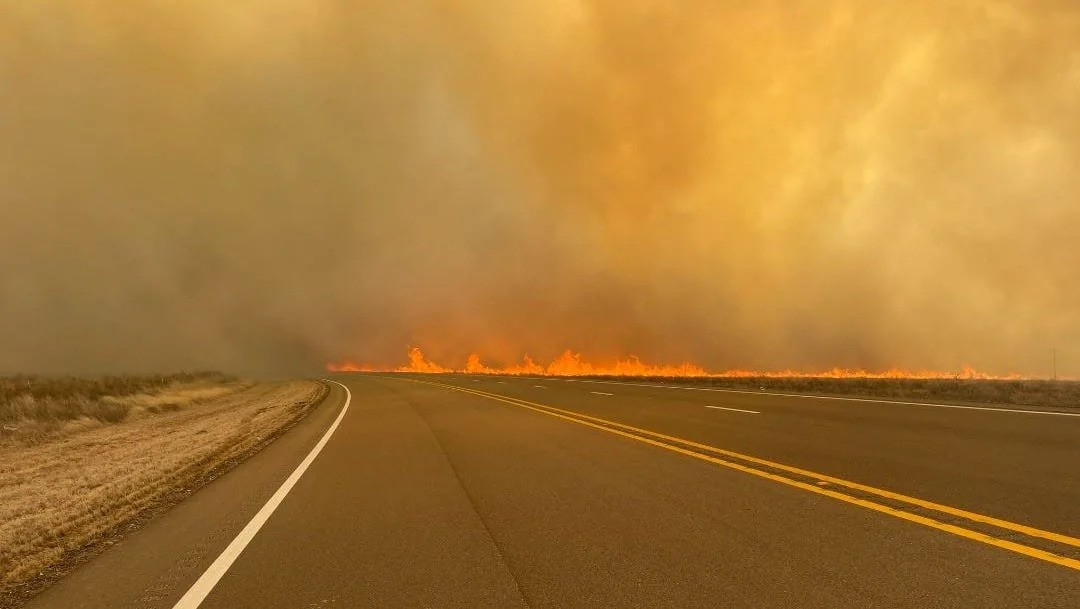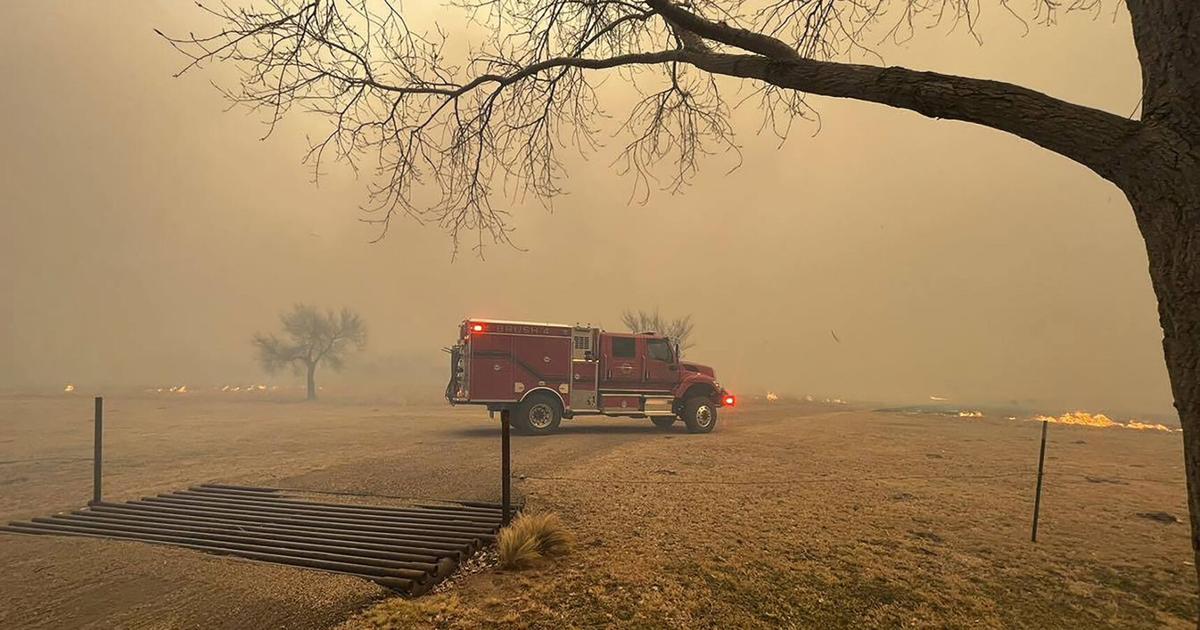Texas Wildfire Becomes Second-Largest In State's History
Texas wildfire becomes second-largest in state's history as the swiftly advancing wildfire raged through the Texas Panhandle on Wednesday. The fire's rapid spread prompted evacuations and caused power outages, challenging firefighters' efforts to contain its expanding reach.
Author:Elisa MuellerReviewer:Tyreece BauerFeb 29, 202425.4K Shares463.4K Views

Texas wildfire becomes second-largest in state's historyas the swiftly advancing wildfire raged through the Texas Panhandle on Wednesday. The fire's rapid spread prompted evacuations and caused power outages, challenging firefighters' efforts to contain its expanding reach.
This extensive inferno was part of a series of fires spiraling out of control, posing threats to rural communities. Local authorities worked tirelessly overnight, closing roads and urging residents to evacuate as the flames encroached upon their homes.
The largest fire, spanning nearly 800 square miles, breached into parts of neighboring Oklahoma, presenting a significant challenge as it continued to burn unchecked at daybreak, as reported by the Texas A&M Forest Service.
While the cause of the fires remains undisclosed, factors such as strong winds, parched grasslands, and unseasonably warm temperatures have exacerbated the situation. In Borger, a town with approximately 13,000 residents, emergency officials addressed concerns from frightened citizens via a Facebook livestream late Tuesday, advising them to prepare for evacuation if they hadn't already done so.
"It was like a ring of fire around Borger. There was no way out ... all four main roads were closed," said Adrianna Hill, 28, whose home was within about a mile of the fire. She said a northern wind that blew the fire in the opposite direction "saved our butts."
Republican Governor Greg Abbott declared a disaster for 60 counties affected by the wildfires. The primary facility responsible for dismantling America’s nuclear arsenal halted operations Tuesday night due to the advancing flames but resumed normal activities on Wednesday.
The wildfires ravaged through thinly populated counties across the vast, elevated plains marked by cattle ranches and oil drilling sites. The main fire, dubbed the Smoke House Creek Fire, ballooned to over half the size of Rhode Island, quintupling in size since it ignited on Monday.
There's a glimmer of hope in the weather forecast for firefighters, with predictions of cooler temperatures, reduced wind, and the possibility of rain on Thursday. Nevertheless, the current situation remains dire in some areas.
As evacuation orders intensified on Tuesday, county and city officials urged residents to activate emergency alert services on their cell phones and be prepared for immediate evacuation. Local emergency officials reported that an unknown number of homes and other structures in the county had been damaged or destroyed.
The Pantex plant, situated northeast of Amarillo, took precautionary measures on Tuesday night by evacuating nonessential staff, as stated by Laef Pendergraft, a spokesperson for the National Nuclear Security Administration’s Production Office at Pantex. Firefighters remained on standby in case of an emergency.
Historically the primary U.S. facility for both assembling and disassembling atomic bombs, Pantex completed its final new bomb in 1991 and has since dismantled thousands. Pantex announced via Twitter early Wednesday that the facility was operational for normal day shift operations, instructing all personnel to report according to their assigned schedules.
As the fires raged on Tuesday, evacuations were mandated in numerous towns northeast of Amarillo, prompting officials in the area of Durham, Oklahoma, to also advise people to flee.
Texas State Senator Kevin Sparks stated that an evacuation order was issued for Canadian, a town of approximately 2,000 residents located about 100 miles (160 kilometers) from Amarillo. Later on Tuesday, the Hemphill County Sheriff’s Office recommended that anyone remaining in Canadian seek shelter either in place or at the high school gymnasium due to road closures.
Additionally, some residents in the small city of Fritch in Hutchinson County were instructed to vacate their homes on Tuesday afternoon as another fire had crossed a highway. A county official confirmed Wednesday afternoon that one individual has lost their life due to the wildfire in Hutchinson County.
"We do have one confirmed fatality from the Scotts Acres (a neighborhood in Stinnett)," Hutchinson County Public Engagement Coordinator Deidra Thomas said.
Although Thomas did not disclose the victim's identity, the family of Joyce Blankenship, 83, informed reporters that she passed away at her residence in Stinnett. Lee Quesada, Blankenship’s step-grandson, expressed that she was highly regarded and cherished within the close-knit community. Her husband, Jimmy, passed away in 2015.
“„She used to be a substitute teacher in the area before she became a housewife while Jimmy worked at the local Phillips refinery. She will be missed by all.- Lee Quesada
On Tuesday evening, the fires were positioned 20 to 25 miles (32 to 40 kilometers) away from Amarillo, with winds carrying smoke into the city, posing potential health risks for individuals with respiratory conditions, according to officials from the National Weather Service.
The weather service issued red-flag warnings and fire-danger alerts for several other states across the central region of the country. Strong winds exceeding 40 mph (64 kph), combined with warm temperatures, low humidity, and dry winter vegetation, created favorable conditions for wildfires.
In central Nebraska, state officials reported that a prairie fire, ignited by a mower, engulfed a vast expanse of grassland approximately equivalent to the size of the state’s largest city, Omaha, on Tuesday.

Elisa Mueller
Author
Elisa Mueller, a Kansas City native, grew up surrounded by the wonders of books and movies, inspired by her parents' passion for education and film.
She earned bachelor's degrees in English and Journalism from the University of Kansas before moving to New York City, where she spent a decade at Entertainment Weekly, visiting film sets worldwide.
With over 8 years in the entertainment industry, Elisa is a seasoned journalist and media analyst, holding a degree in Journalism from NYU. Her insightful critiques have been featured in prestigious publications, cementing her reputation for accuracy and depth.
Outside of work, she enjoys attending film festivals, painting, writing fiction, and studying numerology.

Tyreece Bauer
Reviewer
A trendsetter in the world of digital nomad living, Tyreece Bauer excels in Travel and Cybersecurity. He holds a Bachelor's degree in Computer Science from MIT (Massachusetts Institute of Technology) and is a certified Cybersecurity professional.
As a Digital Nomad, he combines his passion for exploring new destinations with his expertise in ensuring digital security on the go. Tyreece's background includes extensive experience in travel technology, data privacy, and risk management in the travel industry.
He is known for his innovative approach to securing digital systems and protecting sensitive information for travelers and travel companies alike. Tyreece's expertise in cybersecurity for mobile apps, IoT devices, and remote work environments makes him a trusted advisor in the digital nomad community.
Tyreece enjoys documenting his adventures, sharing insights on staying secure while traveling and contributing to the digital nomad lifestyle community.
Latest Articles
Popular Articles
